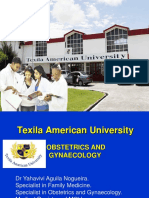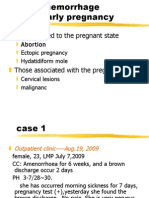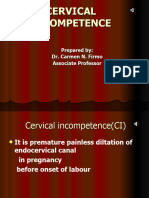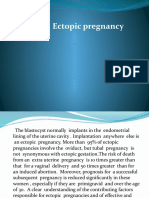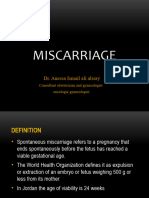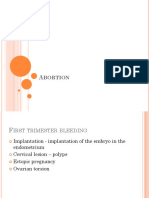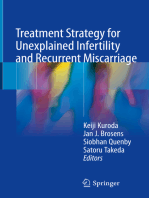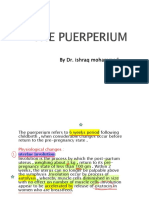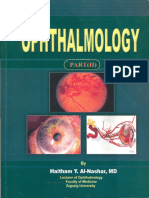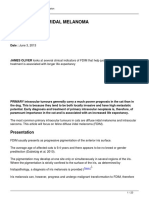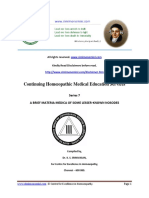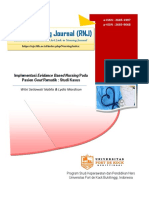0 ratings0% found this document useful (0 votes)
51 views14 Abortion Noted PDF
14 Abortion Noted PDF
Uploaded by
mohammed farajiThis document discusses early pregnancy abnormalities and spontaneous abortion. It defines different types of spontaneous abortion including threatened abortion, inevitable abortion, incomplete abortion, complete abortion, missed abortion, recurrent abortion, and septic abortion. It discusses etiology and risk factors for recurrent abortion including maternal factors, local uterine factors, fetal factors, placental factors, and chromosomal factors. It provides recommendations for management including ultrasonography for threatened abortions, evacuation of remaining products of conception for incomplete abortions, and treatment of infection for septic abortions.
Copyright:
© All Rights Reserved
Available Formats
Download as PDF, TXT or read online from Scribd
14 Abortion Noted PDF
14 Abortion Noted PDF
Uploaded by
mohammed faraji0 ratings0% found this document useful (0 votes)
51 views37 pagesThis document discusses early pregnancy abnormalities and spontaneous abortion. It defines different types of spontaneous abortion including threatened abortion, inevitable abortion, incomplete abortion, complete abortion, missed abortion, recurrent abortion, and septic abortion. It discusses etiology and risk factors for recurrent abortion including maternal factors, local uterine factors, fetal factors, placental factors, and chromosomal factors. It provides recommendations for management including ultrasonography for threatened abortions, evacuation of remaining products of conception for incomplete abortions, and treatment of infection for septic abortions.
Original Title
14 abortion noted.pdf
Copyright
© © All Rights Reserved
Available Formats
PDF, TXT or read online from Scribd
Share this document
Did you find this document useful?
Is this content inappropriate?
This document discusses early pregnancy abnormalities and spontaneous abortion. It defines different types of spontaneous abortion including threatened abortion, inevitable abortion, incomplete abortion, complete abortion, missed abortion, recurrent abortion, and septic abortion. It discusses etiology and risk factors for recurrent abortion including maternal factors, local uterine factors, fetal factors, placental factors, and chromosomal factors. It provides recommendations for management including ultrasonography for threatened abortions, evacuation of remaining products of conception for incomplete abortions, and treatment of infection for septic abortions.
Copyright:
© All Rights Reserved
Available Formats
Download as PDF, TXT or read online from Scribd
Download as pdf or txt
0 ratings0% found this document useful (0 votes)
51 views37 pages14 Abortion Noted PDF
14 Abortion Noted PDF
Uploaded by
mohammed farajiThis document discusses early pregnancy abnormalities and spontaneous abortion. It defines different types of spontaneous abortion including threatened abortion, inevitable abortion, incomplete abortion, complete abortion, missed abortion, recurrent abortion, and septic abortion. It discusses etiology and risk factors for recurrent abortion including maternal factors, local uterine factors, fetal factors, placental factors, and chromosomal factors. It provides recommendations for management including ultrasonography for threatened abortions, evacuation of remaining products of conception for incomplete abortions, and treatment of infection for septic abortions.
Copyright:
© All Rights Reserved
Available Formats
Download as PDF, TXT or read online from Scribd
Download as pdf or txt
You are on page 1of 37
Early pregnancy
abnormalities
Abortion
By Dr. ishraq mohammed
Definition :-
Spontaneous abortion is defined as loss of product of conception prior to 20
week’s gestation .
Because the incidence of conception is unknown, the incidence
of spontaneous abortion (miscarriage) cannot be determined
with certainty.
Spontaneous abortion occurs in 10-15% of clinically recognizable pregnancies.
Evidence would suggest that more than 50% of all conceptions are lost,
the majority in the 14 days following conception.
Real-time ultrasonography has been used
extensively to monitor the intrauterine events
of the first trimester of pregnancy.
If a live, appropriately growing fetus is present at 8 weeks’
gestation, the fetal loss rate over the next 20 weeks (up to 28
weeks) is in the order of 3%.
TYPES OF SPONTANEOUS ABORTION
1- Threatened Abortion:-
The term threatened abortion is used when
a pregnancy is complicated by vaginal bleeding before the 20th week.
Pain may not be a prominent feature of threatened
abortion, although a lower abdominal dull ache sometimes
accompanies the bleeding. Vaginal examination at this
stage usually reveals a closed cervix.
Approximately one-third of pregnant women have some
degree of vaginal bleeding during the first trimester,
and 25-50% of threatened abortions eventually result in loss of the
pregnancy.
2- Inevitable Abortion :-
In the case of inevitable abortion, a clinical
pregnancy is complicated by both vaginal bleeding and cramp
like lower abdominal pain. The cervix is frequently
partially dilated, contributing to the inevitability of
the process.
3- Incomplete Abortion :-
In addition to vaginal bleeding, cramp-like pain, and
cervical dilation, an incomplete abortion involves the
passage of some of the products of conception, often described by
the woman as looking like pieces of skin or liver.
4- Complete Abortion:-
In complete abortion, after passage of all the products of
conception, the uterine contractions and bleeding abate,
the cervix closes, and the uterus is smaller than the
period of amenorrhea would suggest. Ultrasound can be
used to assess the presence of retained placental tissue
if excessive bleeding continues.
In addition, the symptoms of pregnancy are no longer
present, and the pregnancy test becomes negative.
5- Missed Abortion :-
The term missed abortion is used when the fetus
has died but is retained in the uterus, usually for more
than 6 weeks.
Because coagulation problems may develop, fibrinogen
levels should be checked weekly until the fetus
and placenta are expelled (spontaneously) or
removed surgically.
6- Recurrent Abortion:-
Three successive spontaneous abortions usually
occur before a patient is considered to be a recurrent
aborter.
Many clinicians feel that two successive first trimester
losses or a single second-trimester spontaneous abortion
is justification for an evaluation of a couple for the
cause(s) of the pregnancy losses (see genetic evaluation
section that follows).
76- septic Abortion:-
Could happened as a complication of any previously mentioned
types especially incomplete or missed abortion .
ETIOLOGY OF RECURRENT ABORTION
Although many factors may result in the loss of a single
pregnancy, relatively few factors are present consistently in
couples who abort recurrently. Cause and effect relationships
in individual patients are frequently difficult to determine.
1-General Maternal Factors
INFECTION.
Mycoplasma, Listeria, or Toxoplasma
should be specifically sought in women with recurrent abortions
because despite being found infrequently, they are all treatable
with antibioticsز
SMOKING AND ALCOHOL.
PSYCHOSOCIAL STRESS.
Domestic violence and other forms of stress are associated
with a greater risk of pregnancy complications such as
spontaneous abortion, preterm birth, and low birth weight.
MEDICAL DISORDERS.
Diabetes mellitus, hypothyroidism, and systemic lupus erythematosus (SLE)
are associated with recurrent pregnancy loss.
MATERNAL AGE.
If a live fetus is demonstrated by ultrasonography at 8
weeks’ gestational age, fewer than 2% of these pregnancies
will abort spontaneously when the mother is younger than
30 years of age.
2- Local Maternal Factors
Uterine abnormalities
including cervical incompetence, congenital abnormalities
of the uterine fundus (as may result from gestational
exposure to diethylstilbestrol) and acquired abnormalities
of the uterine fundus, are known to be associated with
pregancy loss.
diethylstilbestrol
Cervical incompetence
occurs under a number of circumstances but is usually
the result of trauma.
This occurs most frequently from mechanical dilation of
the cervix at the time of termination of pregnancy, but
it may also occur at the time of diagnostic curettage.
The diagnosis of cervical incompetence is usually made when a mid-
trimester pregnancy is lost with a clinical picture of sudden
unexpected rupture of the membranes, followed by painless expulsion
of the products of conception.
When cervical incompetence is suspected during
pregnancy (e.g., history of cervical incompetence in
a previous ﺷﺴﻮﻱ ؟
pregnancy or of cone biopsy of the
cervix), sequential ultrasonography of the cervix
indicating
funneling or shortness of the cervix or widening
of the lower uterine segment may identify the
problem before a pregnancy loss occurs.
are a set of metal rods of
increasing diameters, from a
few millimeters up to 26
millimeters. The rods are
round, slightly curved, and
have a conal tip. Some sets
have conal tips at both ends
Hegar dilators are used to
induce cervical dilation in
order to gain entry to the
interior of the uterus.
A congenitally abnormal uterus
may be associated with pregnancy loss in both
the first and the second trimesters. Surgical
correction of the abnormality, par- ticularly with
a history of second trimester loss, is frequently
successful.
Complete evaluation of the congenitally abnormal
uterus usually requires laparo-
scopic, hysteroscopic, and hysterographic
examination before any management plan can be
made
The most commonly acquired abnormalities of the uterus
with the potential to affect fecundity are submucous
fibroids.
Although these tend to occur more frequently in
women in their late 30s, they should be considered
when investigating pregnancy loss in all women.
Removal of submucous fibroids and intramural fibroids
larger than 6 cm are associated with improved
fecundity, especially when there is distortion of the
endometrial cavity.
Subserous fibroids do not appear to affect fecundity.
Intrauterine adhesions
result from trauma to the basal layer of the
endometrium from previous surgery or infection. When
most of the uterine cavity has been obliterated
(Asherman syndrome), amenorrhea results.
More frequently, fewer intrauterine adhesions (synechiae)
are present, menses are reasonably normal, and the
lesions are not even suspected until a pregnancy
is attempted and lost.
Surgical correction of these intrauterine adhesions is
recommended to improve fecundity
asherman syndrome
3- Fetal Factors
The most common cause of spontaneous abortion is
a significant genetic abnormality of the conceptus. In spontaneous first-
trimester abortions, approximately two-thirds of fetuses have
significant chromosomal anomalies, with approximately half of
these being autosomal trisomies and the majority of the
remainder
being triploid, tetraploid, or 45,X monosomies.
Fortunately, the majority of these are not inherited from
either mother or father and are single nonrecurring events.
4- Placental Factors
The placental genetic structure is composed of
genes from the mother, the father, and even
imprinted genes from the parents of both the
mother and father.
How these interact and support normal
development and specific diseases is the subject
of intense investigation.
For example the placenta expresses an enzyme 11β-
hydroxylase that converts cortisol to inactive corticosterone,
which protects the fetus from excessive cortisol when the
mother is stressed.
Women with obesity during pregnancy have a
greater risk of developing leptin (a placental peptide)
resistance that leads to a greater risk of fetal IUGR, which
in turn programs the fetus for obesity during
childhood.
5- Chromosomal Factors
Occasionally, fetal chromosomal abnormalities occur as
a result of a chromosomal rearrangement (balanced
translocation or inversion) in either or both
parents.
Therefore, karyotyping is important for evaluation of couples
suffering from recurrent abortion.
6- Immunologic Factors
A successful pregnancy depends on a number of
immunologic factors that allow the host (mother) to
retain a genetically foreign product (fetus) without
rejection
taking place Subsequently during the second half of
pregnancy the adaptive portion of the immune
system is
activated to downregulate the innate immune system
to support the developing fetus.
MANAGEMENT
Threatened Abortion
A threatened abortion is best managed by an ultrasonic
examination to determine the viability of the fetus.
Of those in whom a live fetus is present, 94% will produce a live baby,
although the incidence of preterm delivery in these cases may
be somewhat higher than in those who do not bleed in the
first trimester.
Once a live fetus has been demonstrated to the couple on ultrasonography,
management consists essentially of reassurance .
Incomplete Abortion
Until bleeding has stopped or is minimal, it is best to insert
an intravenous line and take blood for grouping and cross-
matching, as shock may occur from hemorrhage or sepsis.
Once the patient’s condition is stable, the remaining products of conception
should be evacuated from the uterus using appropriate pain
control.
These tissues should be sent for pathologic evaluation.
An incomplete abortion that is infected
must be managed vigorously.
Delay in treatment may result in overwhelming sepsis that may
lead to excessive hemorrhage, renal and hepatic failure,
disseminated intravascular coagulation (DIC), and rarely, death .
Missed Abortion
Suspected missed abortion should be confirmed by
ultrasound to minimize the risk of sepsis and DIC,
and to reduce the extent of hemorrhage and the
degree of pain that accompanies the spontaneous
expulsive process. In some studies vitamin D deficiency
has been associated with early pregnancy loss.
A proposed mechanism is that women with vitamin D
deficiency have an altered immune system. Macrophages
do not make the antibacterial peptide cathelicidin,
which is important in reducing the risk of
infection, as well as contributing to abnormal muscular
function.
General Management Considerations
When the patient is Rh negative and does not have Rh (anti-D)
antibodies, prophylactic RhO-GAM should be administered
Recurrent Abortion
As far as the mother is concerned, it is appropriate to rule out the
presence of systemic disorders such as diabetes mellitus, SLE, and thyroid disease,
and it is also necessary to test for the presence of a lupus
anticoagulant.
Paternal and maternal chromosomes should be evaluated, and hysteroscopy or
hysterography should be performed to evaluate the uterine cavity.
Over half of couples with recurrent losses will have
normal findings during the standard evaluation.
Many of the congenital abnormalities of the uterus can
now be diagnosed using pelvic ultrasonography and
may no longer require laparotomy for repair. Cervical
incompetence is managed by the placement of a
cervical suture (cerclage) at the level of the internal
os; this suture is best placed in the first trimester,
once a live fetus has been demonstrated on
ultrasonography.
The effectiveness of prophylactic cervical cerclage in
preventing recurrent loss from cervical incompe-
tence has not been conclusively established
3 types :
You might also like
- Reading & Writing - ShortDocument12 pagesReading & Writing - Short21 - Đậu Thế Minh Khuê100% (1)
- Elizabeth G. Querubin BSN 3E1-9 - Group 195 A Ectopic PregnancyDocument16 pagesElizabeth G. Querubin BSN 3E1-9 - Group 195 A Ectopic PregnancyLizeth Querubin97% (38)
- Nclex - Mnemonics - Slides - PDF Version 1Document98 pagesNclex - Mnemonics - Slides - PDF Version 1Jan Mitchelle100% (5)
- Abormal PregnancyDocument4 pagesAbormal PregnancyWandy SejeliNo ratings yet
- Ass Ectopic PregnancyDocument10 pagesAss Ectopic PregnancyPriyaNo ratings yet
- Miscarriage & Early Pregnancy LossDocument38 pagesMiscarriage & Early Pregnancy LossLuqman OsmanNo ratings yet
- Executive Functions by Thomas Brown 1Document6 pagesExecutive Functions by Thomas Brown 1api-247044545No ratings yet
- Bleeding in Early PregnancyDocument65 pagesBleeding in Early PregnancyParthi ParthiNo ratings yet
- Abortion and Ectopic PregnancyDocument3 pagesAbortion and Ectopic PregnancyJefelson Eu Palaña NahidNo ratings yet
- 2-Complications of Pregnancy Pt1Document37 pages2-Complications of Pregnancy Pt1pavi7muruganathanNo ratings yet
- MiscarriageDocument45 pagesMiscarriagehasannew807No ratings yet
- Abortionsource 100605123737 Phpapp01Document38 pagesAbortionsource 100605123737 Phpapp01Erina Erichan OtoNo ratings yet
- Early Pregnancy Loss in Emergency MedicineDocument14 pagesEarly Pregnancy Loss in Emergency MedicineMuhammad RezaNo ratings yet
- Abortion: Renhe Hospital Wang JunjieDocument51 pagesAbortion: Renhe Hospital Wang JunjieMadhu Sudhan PandeyaNo ratings yet
- (New) Early Pregnancy Complications RDocument51 pages(New) Early Pregnancy Complications RMesk Banat100% (2)
- Bleeding During PregnancyDocument69 pagesBleeding During PregnancyMohnnad Hmood AlgaraybhNo ratings yet
- AbortionDocument15 pagesAbortionperrybeto879No ratings yet
- MiscarriageDocument38 pagesMiscarriagezianab aliNo ratings yet
- Rupture of The Uterus English RefratDocument11 pagesRupture of The Uterus English RefratassicaNo ratings yet
- Disorders of Early Pregnancy (2 in 1)Document29 pagesDisorders of Early Pregnancy (2 in 1)ipados136No ratings yet
- Ectopic PregnancyDocument5 pagesEctopic PregnancyFaith FuentevillaNo ratings yet
- Cervical IncompetenceDocument28 pagesCervical IncompetenceHoney May Rollan Vicente100% (1)
- Individual Activity #3: CHAPTER STUDY QUESTIONS: Rubric For Short AnswerDocument11 pagesIndividual Activity #3: CHAPTER STUDY QUESTIONS: Rubric For Short AnswerSatanichia McDowell KurumizawaNo ratings yet
- Breast CancerDocument6 pagesBreast CancercchiechieNo ratings yet
- Ectopic Pregnancy: Complication of Pregnancy Uterine CavityDocument7 pagesEctopic Pregnancy: Complication of Pregnancy Uterine CavityÄrmâÑÐ JôŠh BåùtîstâNo ratings yet
- AbortionDocument35 pagesAbortionZahida Aida Ida Paramore100% (1)
- Uterus: Signs and SymptomsDocument11 pagesUterus: Signs and SymptomsJoy Parallag - BautoNo ratings yet
- PLacenta PreviaDocument10 pagesPLacenta Previaeyestrain_ajpn5001No ratings yet
- Bleeding During PregnancyDocument8 pagesBleeding During Pregnancyfernandezrachelle44No ratings yet
- 5 - Abortion or MiscarriageDocument43 pages5 - Abortion or Miscarriageasifdawar2011No ratings yet
- AbortionDocument19 pagesAbortionAhmed SabryNo ratings yet
- Spontaneous Abortion PPDocument47 pagesSpontaneous Abortion PPSurgeon Raza Hamid100% (1)
- Abortion SolenyDocument123 pagesAbortion SolenyAyalewNo ratings yet
- OB B Cervical IncompetenceDocument30 pagesOB B Cervical IncompetencechemniedyavilaNo ratings yet
- Ectopik PregnancyDocument69 pagesEctopik PregnancyNikhil TyagiNo ratings yet
- Vaginal Bleeding in Early PregnancyDocument8 pagesVaginal Bleeding in Early PregnancyBal Ri Mekoleu100% (1)
- Disorders of Female Reproductive SystemDocument6 pagesDisorders of Female Reproductive SystemjoannaNo ratings yet
- Ectopic PregnancyDocument26 pagesEctopic PregnancyMalek.Fakher1900No ratings yet
- Classification: Miscarriage or Spontaneous Abortion Is The Spontaneous End of A Pregnancy at ADocument9 pagesClassification: Miscarriage or Spontaneous Abortion Is The Spontaneous End of A Pregnancy at AAnn GelaNo ratings yet
- Care For The High Risk Pregnant ClientDocument8 pagesCare For The High Risk Pregnant ClientVanessa Marie ManzanoNo ratings yet
- Cervical IncompetenceDocument30 pagesCervical IncompetenceSignor ArasNo ratings yet
- Obsandgyne Tables 200pagesDocument221 pagesObsandgyne Tables 200pagesRashed ShatnawiNo ratings yet
- MK Disorders in Early Pregnancy (OBGY)Document26 pagesMK Disorders in Early Pregnancy (OBGY)Moses Jr KazevuNo ratings yet
- Bleeding in Obstetrics طلبة تمريضDocument16 pagesBleeding in Obstetrics طلبة تمريضzeinabelsayed088No ratings yet
- Ectopic PregenancyDocument69 pagesEctopic PregenancyMahmoud AbbasNo ratings yet
- 1 MiscarriageDocument34 pages1 Miscarriagezxcvbzaki123No ratings yet
- Villena - Embryo Final AssignmentDocument4 pagesVillena - Embryo Final AssignmentKaelNo ratings yet
- AbortionDocument16 pagesAbortionGaurav TripathiNo ratings yet
- Ectopic PregnancyDocument11 pagesEctopic PregnancyPrincess BalloNo ratings yet
- Pathophysiology: Tubal Ectopic PregnancyDocument7 pagesPathophysiology: Tubal Ectopic PregnancyRose Anne TolentinoNo ratings yet
- 1 - Emerg.-In-GyneDocument19 pages1 - Emerg.-In-Gyneharsh9727598705No ratings yet
- Emergency Obstetrics 3Document30 pagesEmergency Obstetrics 3gracebally06No ratings yet
- Course Unit 04 ObDocument9 pagesCourse Unit 04 ObDenise FranciscoNo ratings yet
- Ectopic Pregnancy22Document43 pagesEctopic Pregnancy22Sunil YadavNo ratings yet
- Ectopic Pregnancy1Document34 pagesEctopic Pregnancy1Kreshimaricon FurigayNo ratings yet
- MCN - Individual Activity 3Document23 pagesMCN - Individual Activity 3AngelicaJaneA.SuanNo ratings yet
- Treatment Strategy for Unexplained Infertility and Recurrent MiscarriageFrom EverandTreatment Strategy for Unexplained Infertility and Recurrent MiscarriageKeiji KurodaNo ratings yet
- Hysterectomy A-Z: Why, When, How and What afterFrom EverandHysterectomy A-Z: Why, When, How and What afterRating: 4 out of 5 stars4/5 (2)
- 15 Dystocia Noted PDFDocument43 pages15 Dystocia Noted PDFmohammed farajiNo ratings yet
- 17 The Puerperium Noted PDFDocument39 pages17 The Puerperium Noted PDFmohammed farajiNo ratings yet
- 16 Abnormal Labour Noted PDFDocument92 pages16 Abnormal Labour Noted PDFmohammed farajiNo ratings yet
- 12 13 Genital Tract Infection PDFDocument63 pages12 13 Genital Tract Infection PDFmohammed farajiNo ratings yet
- Skolastik - Literasi Bahasa Inggris - Predicting The Paragraph (SOAL)Document5 pagesSkolastik - Literasi Bahasa Inggris - Predicting The Paragraph (SOAL)annisa auliaNo ratings yet
- Haitham Younis Ai Nashar 2Document522 pagesHaitham Younis Ai Nashar 2MufidahNo ratings yet
- Implant MaximizerDocument3 pagesImplant MaximizerBrettSkillettNo ratings yet
- World Kidney Day 2024Document2 pagesWorld Kidney Day 2024Al BasawiNo ratings yet
- Thesis Results PresentationDocument32 pagesThesis Results PresentationConrad AkelloNo ratings yet
- Makalah Bahasa Inggris 2Document7 pagesMakalah Bahasa Inggris 2azizah LasimpalaNo ratings yet
- Group 4 Case Press. AMOEBIASIS 1Document36 pagesGroup 4 Case Press. AMOEBIASIS 1Alliyah SalindoNo ratings yet
- Routes of Administration ReferencesDocument55 pagesRoutes of Administration ReferencesVictoria Eliza InguilloNo ratings yet
- Neurology MCQ MixDocument53 pagesNeurology MCQ Mixezati pedramNo ratings yet
- CLINICAL CHEMISTRY - Specimen CollectionDocument4 pagesCLINICAL CHEMISTRY - Specimen CollectionthedarkwingNo ratings yet
- NCP-CKD LabcoDocument5 pagesNCP-CKD Labcojay kusainNo ratings yet
- Clinical Pharmacy PracticeDocument5 pagesClinical Pharmacy PracticenuhaNo ratings yet
- Symptoms End Signs of Musculoskeletal SystemDocument70 pagesSymptoms End Signs of Musculoskeletal SystemErde NmuNo ratings yet
- Feline Diffuse Iridal Melanoma: PresentationDocument23 pagesFeline Diffuse Iridal Melanoma: PresentationJosh LittleNo ratings yet
- Paediatric Growth Chart Interpretation & Documentation - OSCE GuideDocument9 pagesPaediatric Growth Chart Interpretation & Documentation - OSCE GuidePrashant PalNo ratings yet
- Level 2. How Do Cigarettes Affect The Body - Krishna SudhirDocument3 pagesLevel 2. How Do Cigarettes Affect The Body - Krishna SudhirELIBERTO FIGUEROA OMENo ratings yet
- Lembar Kerja Siswa Virus CoronaDocument18 pagesLembar Kerja Siswa Virus CoronaChintiya PutriNo ratings yet
- Cebu Doctors' University College of Nursing Mandaue City, Cebu NCM 109 Theory Postnatal ComplicationsDocument47 pagesCebu Doctors' University College of Nursing Mandaue City, Cebu NCM 109 Theory Postnatal ComplicationsJanica Rose Maloloy-onNo ratings yet
- Brief Materia Medica Lesser-Known NosodesDocument103 pagesBrief Materia Medica Lesser-Known NosodesFuente Delavida100% (1)
- The Significance of Past History 2Document15 pagesThe Significance of Past History 2ranjan.rohini259No ratings yet
- REAL in Nursing Journal (RNJ) : Implementasi Evidance Based Nursing Pada Pasien Gout Rematik: Studi KasusDocument8 pagesREAL in Nursing Journal (RNJ) : Implementasi Evidance Based Nursing Pada Pasien Gout Rematik: Studi KasusDHANY MRNo ratings yet
- Monica Sok HonorsthesisDocument108 pagesMonica Sok Honorsthesispearl ikebuakuNo ratings yet
- New Directions in The Treatment of HypoparathyroidismDocument6 pagesNew Directions in The Treatment of Hypoparathyroidismmiguel saba sabaNo ratings yet
- Test On CirculationDocument1 pageTest On Circulationdikshathakare455No ratings yet
- What You Need To Know: HPV (Human Papillomavirus) VaccineDocument2 pagesWhat You Need To Know: HPV (Human Papillomavirus) VaccineBella N.No ratings yet
- Chapter 41 - Hepatitis VirusesDocument22 pagesChapter 41 - Hepatitis VirusesBibi Rabiah NoorNo ratings yet
- Gross Anatomy: ExampleDocument7 pagesGross Anatomy: ExampleJerwin TullaoNo ratings yet









